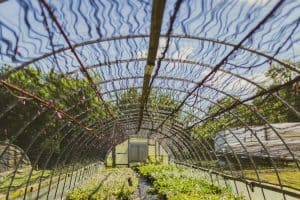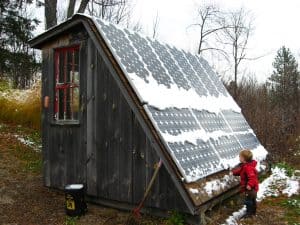Yes, there are different types of greenhouses just like there are different types of normal houses. Who’d have guessed it other than architects trying to remain employed?
While you may think the decision regarding which type of greenhouse you choose is an unimportant aesthetic one, the wrong choice could have dramatic effects. So, let us help you choose the best type of greenhouse for you by telling you what each option is best and worst at. From there, you can make a decision based on the strengths and weaknesses of the structure as opposed to what the attendant at Lowe’s or Home Depot recommends.
The Types of Greenhouses to Consider

So you’ve decided that you want a greenhouse to grow plants in year round. But, now that you’ve started researching the specifics of greenhouses you’ve found that:
- Explanations are convoluted and science-y
- Instructions are harder to follow than they should be
- Products aren’t best for the consumer but instead are optimized for sales
- You may need a permit
Well, we want to give you the information that’s best for you – period. The type of greenhouse that you choose should be the one that helps you the most, not the one that puts the most money in our pockets. So, let’s talk different types of greenhouses worth considering, shall we?
What is a Gable Roof?
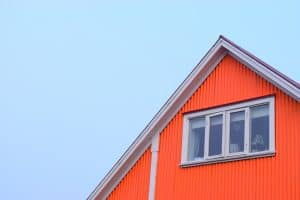
A gable roof is the one that you drew as a kid – two sections at about a 45-degree angle that meet at an intersection called the roof ridge. These roofs are ideal for temperate and cool climates, though they’re built pretty universally across the world. You’ll need some sort of rafters or trusses to help stabilize your greenhouse gable roof, but the results will be worth it.
It is worth noting that a gable roof is going to go in a larger, more intricate, greenhouse. If you’re looking for a smaller build, then there is a better option on this list for you. If you’re considering a larger-scale greenhouse, then a gable roof may be just what you’re looking for.
The coolest thing about a gable roof greenhouse has to be the way in which they can be tweaked to your environment. For example, live in the mountains? Well, reduce the pitch of your greenhouse’s roof to work with that snow – not against it. For comparison, if you live in a particularly windy and rainy environment, then a more severe pitch is in order to keep the wind and water out.
What is an A-Frame?

Did you know that A-frame houses do a surprisingly good job of conserving energy? And, did you know that their shape makes them ideal for solar?
So, while an A-frame greenhouse may have more external square footage and less interior square footage than a gable of the same size, it does have the benefit of being more self-sufficient. If you’re in this for the environment, then this can be a massive box checked.
Another box that needs to be checked is the aesthetic. While we normally aren’t ones for the looks of a greenhouse too much, an A-frame is a style that’s either loved or hated. So, do you love the aesthetic? Or, do you think it’ll get old quickly? If you’re leaning towards the latter then maybe it’s worth continuing on in your peruse of this post.
Another factor worth considering is, can you optimize the space? You’ll have a lot of headspace that you can either take advantage of, or waste. Might recommend some vertical gardening or a hanging terrarium to take care of that otherwise unused space?
What is a Hoop House?
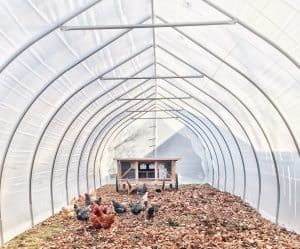
When you think of a backyard greenhouse, then chances are you’re picturing a hoop-house. They’re constructed by a series of hoops – made from a variety of different materials – that are covered with a thick greenhouse specific plastic. The concept is so simple, and the results are good enough. There’s a reason why hoop-houses are so popular as greenhouses.
So, the pros of the hoop house are pretty obvious – low cost and adjustable in size (more or less hoops equals a bigger or smaller house). But, what about the cons? Well, the biggest one is going to be in regards to insulation – there effectively is none. As a result, you’ll have to work harder to heat and cool your greenhouse.
A hoop-house is going to give you a month of extra growing time on both sides of the year, which is a great benefit to have for some people. For those in harsher climates though, a hoop-house is probably not the best option. Typically the growing season is April to October, but if your growing season is shorter because of where you live, then you won’t magically be able to grow plants all year round with the help of a hoop-house.
A hoop-house is best for those not looking to garden when there are mounds of snow outside and who instead just want to squeeze all the extra harvesting out of the year that they can.
What is a Gothic Arch Greenhouse?
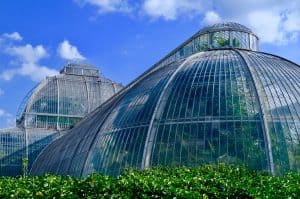
If you’re from the U.S. then gothic may be a little foreign to you. The best way to understand what a Gothic arch is, is to think about the Cathedral at Notre Dame (or, Hogwarts in the Harry Potter universe). Think of those high-vaulted ceilings with the curved stone buttresses – that’s gothic.
While you may not use stone like they did in the late Middle Ages, the idea of a Gothic arch is still one worth considering. The reason? Well, those late Middle Age architects devised a way to store the weight of the building in the arches as opposed to the walls. This got rid of the need for small rooms and lots of walls and instead lead to some of the greatest open-plan architectural marvels the world has ever seen (ever seen the Hagia Sofia?).
While you aren’t constructing a palace meant to withstand centuries, you can still use these gothic architectural ideas in your greenhouse. A lot of botanic gardens have a gothic design because it allows them to be big and tall without supports taking up space in which the plants could be.
Yes, you may not be building a backyard botanic garden, but alleviating the stress put on your greenhouse walls by devising a Gothic arch into your greenhouse’s design could lengthen the life of your oasis considerably. Remember, this old Gothic architectural trick is both functional and beautiful.
What is a Geodesic Dome?
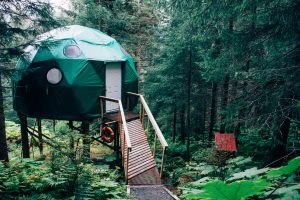
Similarly to the Gothic arch, the geodesic dome is designed to redistribute the weight of the structure in a manner that is conducive to taking on heavier loads. The design relies on the structural strength of the triangle and a lattice shell design. Essentially, the triangles are put together like puzzle pieces in a way that uses
While the idea of a geodesic dome may seem otherworldly, they aren’t as uncommon as you may think. You know the globe at Epcot – geodesic dome. The Nagoya Dome in Japan that houses a number of professional sports team is also based off the Buckminster Fuller design. So, while you may not be able to picture that geodesic dome greenhouse out there in the backyard yet, the neighbors will accept it quicker than you may think.
What is a Lean-to Greenhouse?
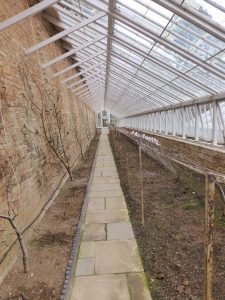
If you’ve ever watched a survival show like Survivorman, then you know what a lean-to is. Actually, chances are you can use context clues to garner a basic understanding of what it is. If you can’t, then here’s the explanation – it’s a structure that, now wait for it, leans onto something else for support.
Lean-tos can be super simple like you see in the survival shows or more legitimately built as in the photo above. The choice of how you want to employ a lean-to design for your greenhouse is up to you. Many people find that the lean-to is great for greenhouses because it allows them to attach the structure directly to the house for easier access.
I could certainly imagine how the proximity of the greenhouse would inspire gardening that would otherwise go by the wayside. Now that we’ve gone over the same pro to lean-to greenhouses, though, it only makes sense to discuss the cons too.
The main con for a lean-to greenhouse is going to be how the weight of the additional structure is dispersed onto the already existing structure. Consider this, the architect of your house did meticulous mathematical calculations to decide to construct the building as it was constructed. You can’t just go adding weight to that building willy-nilly because the architect didn’t plan for this additional weight in his designs.
So, if you’re going to do a lean-to greenhouse attached to your abode, then chances are you’re going to need some permits. While this sounds scary, talk to your local building regulators to get a better understanding of what all this will consist.
What is a Shade House?
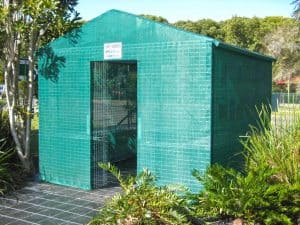
Some plants love the sun and some plants only like the sun a little bit. The latter type of plants are going to do best in a shade house as opposed to a traditional greenhouse. A shade house uses mesh, fabric, or wooden slats to create a shaded outdoor area in which you can grow plants.
So, why are some plants going to flourish in such a different environment? Well, certain species have unique needs in terms of light sensitivity, dryness levels, and temperature thresholds because they’re native to a particular place in the world. A shade house will allow us to grow plants that aren’t domestic to our area by adjusting the environment in an environmentally conscious way.
It’s worth noting that the number of plants that prefer a shade house to a traditional greenhouse is the minority. Do you research and be sure that the plants you want to grow really prefer shade to sun before purchasing a shade house.
What is a Sawtooth?
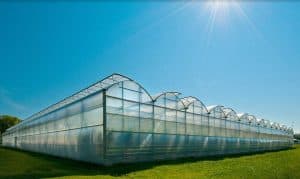
This type of greenhouse is definitely geared towards the wholesaler. If you need to grow plants, and I mean a lot of them, then this is probably the best option for you. Think of this purchase like buying a cold-frame from Costco – you’re getting the goldilocks of quality, cost, square-footage, and performance.
Some sawtooth greenhouses are bigger than others, so do your research to find one that’s the right size for you. If you choose one that’s particularly large, then you’ll need to be extra cognizant of ventilation. Chances are though, that wherever you purchase your sawtooth greenhouse you’ll also be able to buy the necessary gear to get your greenhouse functional.
Greenhouse Types Worth Talking About
If you aren’t sure which type of greenhouse is for you, then ask about it in the comments. We’d be happy to help provide the answer and you may just find that someone reading this post can too! For context, consider some light reading on the costs associated with greenhouse ownership – the figures may surprise you.
Are you considering building this greenhouse yourself? Give our guide to DIY greenhouses a read before you start so that you know what you’re getting into.
Getting a greenhouse can be an extremely fulfilling experience, one sure to provide hours of enjoyment for you and your whole family. Plus, think of all the possible snacks for you, your friends, your family, and your neighbors! The different types of greenhouses can be confusing, but now you know that one that’ll help accentuate your green thumb, right?


